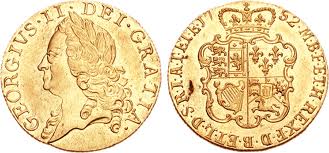|
The Guniea was first minted in 1663 during the reign of Charles II. It took its name from Guniea which is situated on the West Coast of Africa, from which most of the gold used in the coins was imported. At the outset it was worth one pound or twenty shillings and from its introduction all British Coins were machine made rather than hammered by hand. For a period after the formation of the Royal African Company in 1672, the guinea coin featured the company's elephant and castle logo (seen here beneath the King's head).  Rises in the price of gold caused the value of the guinea to increase, at times to as high as thirty shillings but from 1717 untill 1816, its value was officially fixed at twenty-one shillings. An example of its use in Dorchester Documentation is the Will of Mary Leigh the wife of the Rector of Holy Trinity and St Peters Churches in Dorchester which was drawn up in 1738. By then the coin looked like the images shown below as George II reigned from 1727 until 1760. 
|